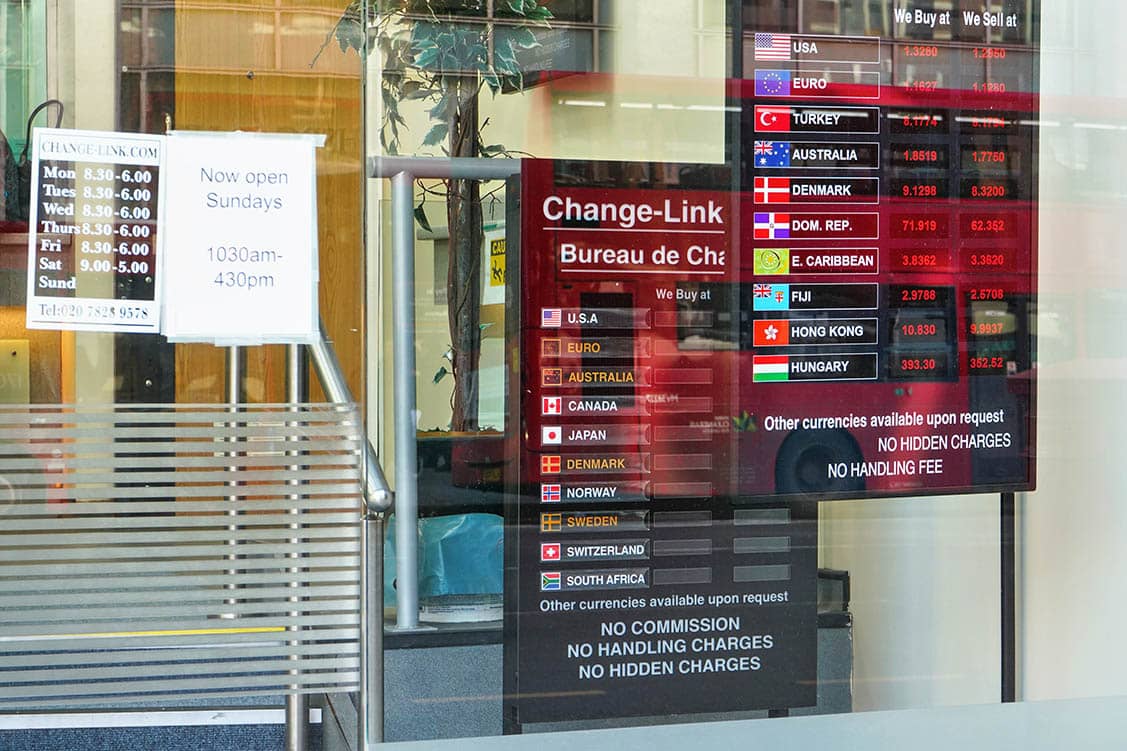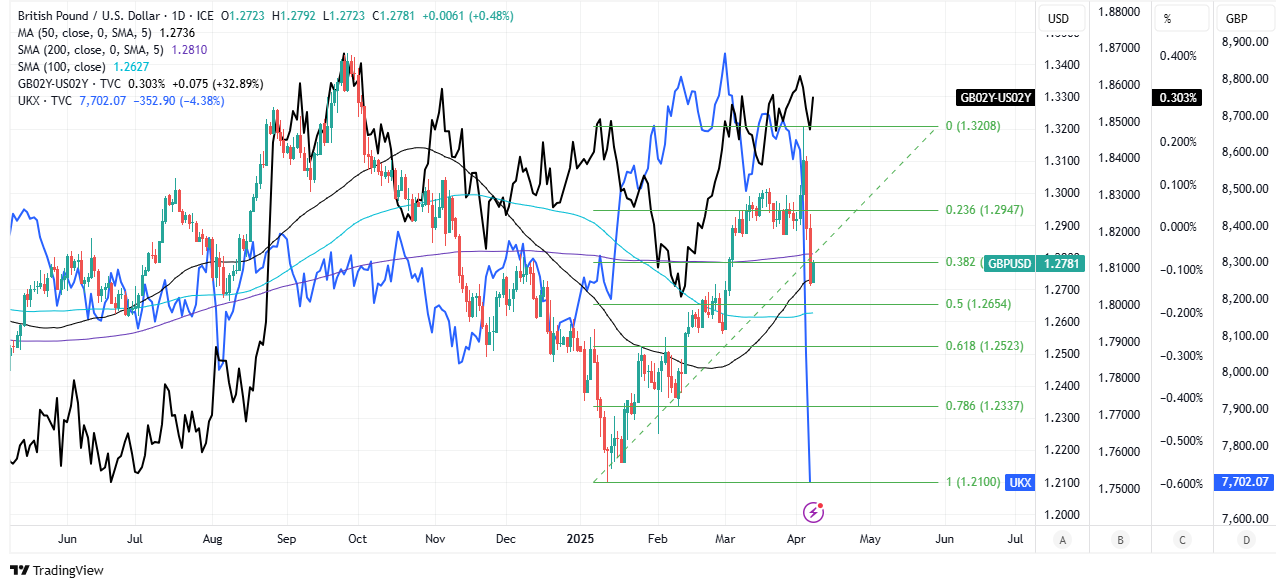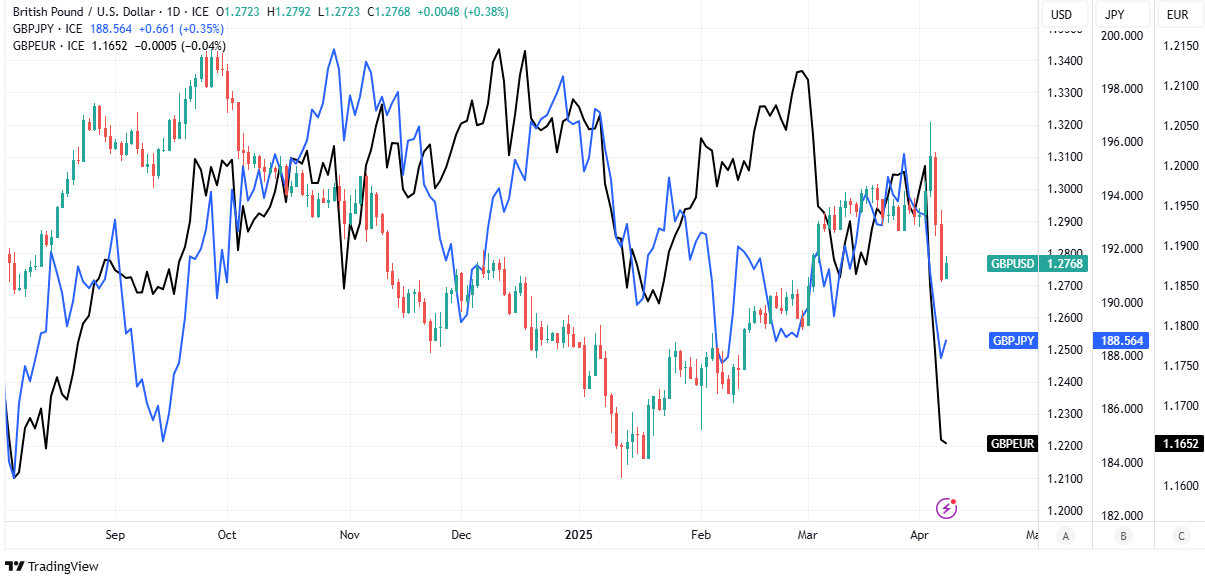- GBP asset correlations converge as markets slide
- GBP/USD falls below major, long-term pivot level
- PBoC’s GBP/CNY fix creates resistance near pivot
- Traders on JPMorgan FX desk scent blood in water
- Sold GBP/JPY, GBP/EUR, citing Storm Rachel fears
- Still some scope for GBP/USD recovery from here

Image © Adobe Images
The Pound to Dollar rate fell below a major long-term pivot level on Monday and could now face headwinds on any recovery above 1.2850 on Tuesday, including sales associated with Beijing’s management of GBP/CNY, and possible further sales of GBP/JPY and GBP/EUR from the FX desk at JPMorgan.
GBP/USD fell 1.68% to one-month lows around 1.2714 ahead of the London close on Monday after President Donald Trump announced a counter-response to China’s Friday retaliation against the new and higher trade tariffs unveiled by the White House on Wednesday last week.
The latest included an additional 50% tariff on all imports from China, which took the total US levy to 104% and saw UK government bonds also thrown on a market bonfire as an earlier rout in global equities intensified and GBP/USD fell below a major pivot level at 1.2870 on the charts.
“I think this set-up is just plain awful for sterling - a huge debt pile on stretched fiscal limits and pinning all hope on a dramatic increase in growth and productivity - Starmer is right to be worried,” says Laoise Ni Thighearnaigh, a trader on the FX desk at JPMorgan, in a Monday market commentary.
Above: Pound to Dollar rate at daily intervals with Fibonacci retracements and selected moving averages indicating possible areas of support. Shown alongside FTSE 100 stock index (blue) and spread between 2-year GB and US bond yields (black). Click for closer inspection.
“The push and pull of anti-US exceptionalism USD supply, and hair-on-fire risk-off USD demand, is incredibly hard to navigate, so we are keeping our GBP shorts against EUR and JPY,” she adds.
Monday’s slump in Sterling followed a near-2% loss on Friday when the Pound was the most widely sold of all the G10 currencies among hedge fund clients, according to Thighearnaigh. Turnover in GBP/USD reached $10.33 billion on the interbank market that day, which was 157.07% above its 12-week daily average.
Any stabilisation of global markets would likely see the tentative rebound in pairs like GBP/USD, GBP/JPY and GBP/EUR extend further from here, however, for Tuesday GBP/USD will face headwinds associated with Beijing’s management of GBP/CNY once back above 1.2848, and likely insurmountable resistance at 1.2880.
This is partly because the People’s Bank of China lowered its central parity fixing for GBP/CNY to 9.2563 on Tuesday, from 9.3439, and lifted its central parity for USD/CNY to 7.2038, from 7.1980. However, it’s also because Beijing cannot enforce the topside limits in those pairs without also imposing a cap on GBP/USD.
Above: GBP/USD at daily intervals alongside GBP/JPY and GBP/EUR. Click for closer inspection.
Beyond Tuesday, there may be scope for a more protracted recovery in the likes of GBP/USD, GBP/JPY and GBP/EUR if US inflation numbers come in soft on Thursday, or if misplaced pessimism about the US growth outlook and a deterioration of other similarly-important fundamentals begin to weigh on the Dollar again.
“Yesterday's announcement is another nail in the coffin of the post-1989 golden era of profit growth. Geopolitical stability and technological advance made hyper globalisation possible, in turn contributing to the rise of US profits as a percentage of GDP in every decade since the 1980s,” says Freya Beamish, chief economist at TS Lombard, in a research briefing last Thursday.
“A major driver here was the positive supply shock of a huge amount of cheap labour coming online. Some form of industrial policy was always going to be necessary to redress this, once those left behind by this process became numerous enough, which is certainly now the case. Trump has chosen negative supply shocks - tariffs and deportations, with a question mark over energy supply - reversing the impact of policy on profits and risking permanently re-rating valuations around a new lower geopolitical average,” she adds.
Donald Trump’s reform agenda might yet prove to be bullish for the real economy and regular people on Main Street in the US but it comes at the expense profits and margins for corporate America, which makes it toxic for the lofty valuations prevailing in US stock markets, hence why any enduring stabilisation of global markets could yet see the Dollar role over again, to the benefit of Sterling and other currencies, if the White House continues with its current tariff strategy.


